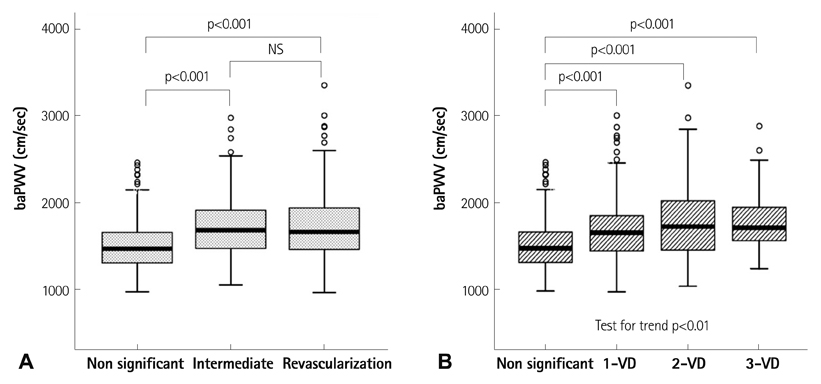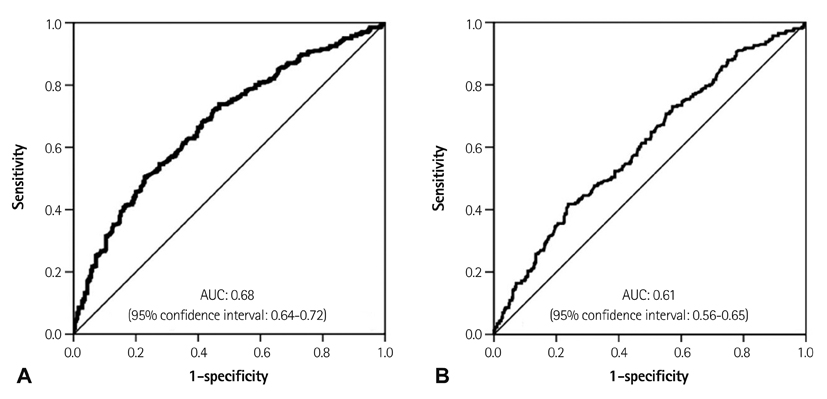Korean Circ J.
2013 Apr;43(4):239-245. 10.4070/kcj.2013.43.4.239.
The Brachial Ankle Pulse Wave Velocity is Associated with the Presence of Significant Coronary Artery Disease but Not the Extent
- Affiliations
-
- 1Department of Cardiology, Sejong General Hospital, Bucheon, Korea. drjih@naver.com
- KMID: 2224946
- DOI: http://doi.org/10.4070/kcj.2013.43.4.239
Abstract
- BACKGROUND AND OBJECTIVES
Arterial stiffness is well known as an important risk factor for cardiovascular disease. At our institution, we assessed the association between arterial stiffness, as determined by brachial ankle pulse wave velocity (baPWV), and the extent of coronary artery disease (CAD), as detected by conventional coronary angiography (CAG) in patients who visited the outpatient clinic for angina without any previous history of heart disease. In addition, we evaluated if the level of baPWV could predict the revascularization as a clinical outcome.
SUBJECTS AND METHODS
On a retrospective basis, we analyzed the data of 651 consecutive patients who had undergone baPWV and elective CAG for suspected CAD between June 2010 and July 2011, at a single cardiovascular center.
RESULTS
The baPWV was one of the statistically meaningful predictors of significant CAD (diameter of stenosis >50%) in addition to male gender, age, the level of high density lipoprotein-cholesterol, and hemoglobin A1c in multivariate analysis. However, baPWV was not the significant predictor of revascularization. When the extent of CAD was classified into following 4 groups; no significant CAD, 1-, 2- and 3-vessel disease, there was significant difference of baPWV between the significant and non-significant CAD group, but there was no difference of baPWV among the 3 significant CAD groups, although there was a trend toward the positive correlation.
CONCLUSION
Although baPWV was an independent predictor of significant CAD, it was neither associated significantly with the extent of CAD nor with the risk of revascularization. Therefore, baPWV has a limited value for portending the severity of CAD in patients with chest pain.
MeSH Terms
-
Ambulatory Care Facilities
Animals
Ankle
Atherosclerosis
Cardiovascular Diseases
Chest Pain
Constriction, Pathologic
Coronary Angiography
Coronary Artery Disease
Coronary Vessels
Heart Diseases
Hemoglobins
Humans
Male
Multivariate Analysis
Pulse Wave Analysis
Retrospective Studies
Risk Factors
Vascular Stiffness
Hemoglobins
Figure
Reference
-
1. Amar J, Ruidavets JB, Chamontin B, Drouet L, Ferrières J. Arterial stiffness and cardiovascular risk factors in a population-based study. J Hypertens. 2001. 19:381–387.2. Vlachopoulos C, Aznaouridis K, Stefanadis C. Prediction of cardiovascular events and all-cause mortality with arterial stiffness: a systematic review and meta-analysis. J Am Coll Cardiol. 2010. 55:1318–1327.3. Mitchell GF, Hwang SJ, Vasan RS, et al. Arterial stiffness and cardiovascular events: the Framingham Heart Study. Circulation. 2010. 121:505–511.4. Lehmann ED, Gosling RG, Sönksen PH. Arterial wall compliance in diabetes. Diabet Med. 1992. 9:114–119.5. London GM, Marchais SJ, Safar ME, et al. Aortic and large artery compliance in end-stage renal failure. Kidney Int. 1990. 37:137–142.6. Nam HJ, Jung IH, Kim J, et al. Association between brachial-ankle pulse wave velocity and occult coronary artery disease detected by multi-detector computed tomography. Int J Cardiol. 2012. 157:227–232.7. Kullo IJ, Bielak LF, Turner ST, Sheedy PF 2nd, Peyser PA. Aortic pulse wave velocity is associated with the presence and quantity of coronary artery calcium: a community-based study. Hypertension. 2006. 47:174–179.8. Laurent S, Boutouyrie P, Asmar R, et al. Aortic stiffness is an independent predictor of all-cause and cardiovascular mortality in hypertensive patients. Hypertension. 2001. 37:1236–1241.9. Yamashina A, Tomiyama H, Takeda K, et al. Validity, reproducibility, and clinical significance of noninvasive brachial-ankle pulse wave velocity measurement. Hypertens Res. 2002. 25:359–364.10. Kim HJ, Nam JS, Park JS, et al. Usefulness of brachial-ankle pulse wave velocity as a predictive marker of multiple coronary artery occlusive disease in Korean type 2 diabetes patients. Diabetes Res Clin Pract. 2009. 85:30–34.11. Yamashina A, Tomiyama H, Arai T, et al. Brachial-ankle pulse wave velocity as a marker of atherosclerotic vascular damage and cardiovascular risk. Hypertens Res. 2003. 26:615–622.12. Liu CS, Li CI, Shih CM, et al. Arterial stiffness measured as pulse wave velocity is highly correlated with coronary atherosclerosis in asymptomatic patients. J Atheroscler Thromb. 2011. 18:652–658.13. Xu Y, Wu Y, Li J, et al. The predictive value of brachial-ankle pulse wave velocity in coronary atherosclerosis and peripheral artery diseases in urban Chinese patients. Hypertens Res. 2008. 31:1079–1085.14. Imanishi R, Seto S, Toda G, et al. High brachial-ankle pulse wave velocity is an independent predictor of the presence of coronary artery disease in men. Hypertens Res. 2004. 27:71–78.15. Kingwell BA, Waddell TK, Medley TL, Cameron JD, Dart AM. Large artery stiffness predicts ischemic threshold in patients with coronary artery disease. J Am Coll Cardiol. 2002. 40:773–779.16. Mancia G, De Backer G, Dominiczak A, et al. 2007 Guidelines for the Management of Arterial Hypertension: The Task Force for the Management of Arterial Hypertension of the European Society of Hypertension (ESH) and of the European Society of Cardiology (ESC). J Hypertens. 2007. 25:1105–1187.17. Asmar R, Benetos A, Topouchian J, et al. Assessment of arterial distensibility by automatic pulse wave velocity measurement. Validation and clinical application studies. Hypertension. 1995. 26:485–490.18. Asmar R, Topouchian J, Pannier B, et al. Scientific, Quality Control, Coordination and Investigation Committees of the Complior Study. Pulse wave velocity as endpoint in large-scale intervention trial. The Complior study. J Hypertens. 2001. 19:813–818.19. Safar ME, Henry O, Meaume S. Aortic pulse wave velocity: an independent marker of cardiovascular risk. Am J Geriatr Cardiol. 2002. 11:295–298.20. Mattace-Raso FU, van der Cammen TJ, Hofman A, et al. Arterial stiffness and risk of coronary heart disease and stroke: the Rotterdam Study. Circulation. 2006. 113:657–663.21. Tomiyama H, Koji Y, Yambe M, et al. Brachial -- ankle pulse wave velocity is a simple and independent predictor of prognosis in patients with acute coronary syndrome. Circ J. 2005. 69:815–822.22. Tsuchikura S, Shoji T, Kimoto E, et al. Brachial-ankle pulse wave velocity as an index of central arterial stiffness. J Atheroscler Thromb. 2010. 17:658–665.23. Tomiyama H, Yamashina A, Arai T, et al. Influences of age and gender on results of noninvasive brachial-ankle pulse wave velocity measurement--a survey of 12517 subjects. Atherosclerosis. 2003. 166:303–309.24. Yambe M, Tomiyama H, Hirayama Y, et al. Arterial stiffening as a possible risk factor for both atherosclerosis and diastolic heart failure. Hypertens Res. 2004. 27:625–631.25. Boutouyrie P, Tropeano AI, Asmar R, et al. Aortic stiffness is an independent predictor of primary coronary events in hypertensive patients: a longitudinal study. Hypertension. 2002. 39:10–15.26. Demer LL. Effect of calcification on in vivo mechanical response of rabbit arteries to balloon dilation. Circulation. 1991. 83:2083–2093.27. Seo WW, Chang HJ, Cho I, et al. The value of brachial-ankle pulse wave velocity as a predictor of coronary artery disease in high-risk patients. Korean Circ J. 2010. 40:224–229.28. Igarashi Y, Chikamori T, Tomiyama H, et al. Diagnostic value of simultaneous brachial and ankle blood pressure measurements for the extent and severity of coronary artery disease as assessed by myocardial perfusion imaging. Circ J. 2005. 69:237–242.
- Full Text Links
- Actions
-
Cited
- CITED
-
- Close
- Share
- Similar articles
-
- Association Between the extent of Subclinical Atheroscelrosis and Pulse Wave Velocity in the Elderly
- Usefulness of Brachial-Ankle Pulse Wave Velocity and Ankle-Brachial Index as Predictors of Early Age-Related Maculopathy
- Noninvasive surrogates in assessing the severity of coronary atherosclerosis
- Increased arterial stiffness causing resistant hypertension in an adolescent with Neurofibromatosis type 1
- Relationship between Cardiac Autonomic Neuropathy and Brachial-ankle Pulse Wave Velocity in Type 2 Diabetics



